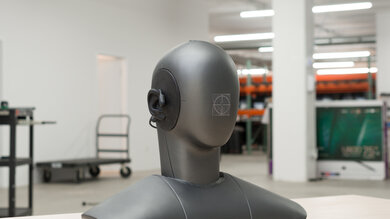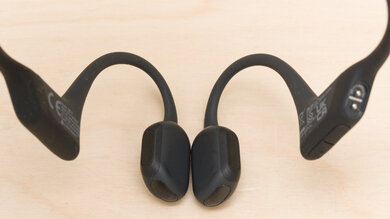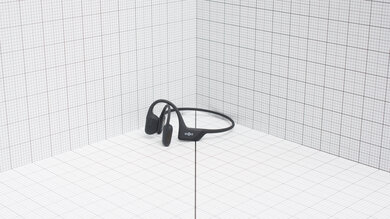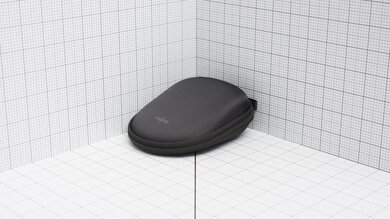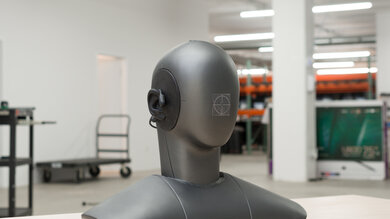The Shokz OpenRun Pro Bone Conduction are the upgraded version of the Shokz OpenRun Bone Conduction. Like their sibling, they use vibrations on your cheekbones rather than speakers to conduct sound, leaving your ears completely open so that you can hear your surroundings. The Pro model also has 'TurboPitch Technology', which aims to improve their bass reproduction. Like other bone conduction headphones, they still lack a thumpy, punchy sound, so tracks sound flat. This isn't much of a problem for vocals and lead instruments, which sound clear, accurate, and neutral. Overall, they don't look or sound like regular headphones. However, their sporty IP55 rating for dust and water resistance combined with their stable and comfortable fit make them a unique choice if you want to stay aware of your environment without sacrificing your audio.
Our Verdict
The Shokz OpenRun Pro are disappointing for neutral sound. These headphones reproduce sound by creating vibrations on your cheekbones, which travel to your inner ear. As a result, our testing rig can't adequately measure their performance. In real-life usage, they have difficulty reproducing a thumpy, rumbly bass and mixes sound flat. However, they do a significantly better job with the mid-range. Vocals and lead instruments sound clear, accurate, and neutral. Their treble range is also fairly balanced and isn't too bright. However, due to their bone conduction design, they're prone to inconsistencies in audio delivery if the transducers don't sit well on your cheekbones.
- Stable, comfortable, and well-built design.
- Prone to inconsistencies in audio delivery.
- Really lack low-bass.
The Shokz OpenRun Pro are sub-par for commute and travel. They aren't designed for this purpose, as they don't block out any background sound and leak audio at high volumes. That said, they have a comfortable and stable fit, are well-built, and come with a hard carrying case to help protect them when you're on the go. They also deliver over 14 hours of continuous playback time, which easily lasts through long days on the go.
- Stable, comfortable, and well-built design.
- Over 14 hours of continuous playback time.
- Don't block out any background noise.
- Prone to inconsistencies in audio delivery.
- Leak audio at high volumes.
The Shokz OpenRun Pro are decent for sports and fitness. Thanks to their bone conductor design, you can stay aware of your surroundings during tough workouts in the park. They have a stable ear hook design, making it difficult for them to fall off your head, and a comfortable, lightweight fit. They're also well-built and with an IP55 rating for dust and water resistance. However, you can't put these headphones into your pocket when you're not using them, but you can wear them around your neck in a pinch.
- Stable, comfortable, and well-built design.
- IP55 rating for dust and water resistance.
- Prone to inconsistencies in audio delivery.
The Shokz OpenRun Pro are a suitable choice for office use as they allow you to monitor your office space while still delivering your audio. Due to their design, they don't block out background noise, and they leak audio at high volumes, which can annoy others around you if your office doesn't have a door. However, they have a comfortable design, support multi-device pairing, last over 14 hours continuously, and the mic is fine for calls if you don't have much background noise.
- Support multi-device pairing.
- Over 14 hours of continuous playback time.
- Don't block out any background noise.
- Prone to inconsistencies in audio delivery.
- Leak audio at high volumes.
The Shokz OpenRun Pro are Bluetooth-only headphones. They're compatible with Bluetooth-enabled PCs, but their latency is too high for gaming.
The Shokz OpenRun Pro are Bluetooth-only headphones, and you can't use them wired.
The Shokz OpenRun Pro are sub-par for phone calls. Their integrated mic has decent recording quality, ensuring that your voice sounds clear and natural to whoever you're talking to. That said, the mic struggles to separate your voice from moderate ambient noise, so if you're calling from a busy street or office, speech can be drowned out. As these headphones don't enter or cover your ears at all, they won't block out any background noise, making it harder to hear your call well.
- Decent recording quality.
- Don't block out any background noise.
- Prone to inconsistencies in audio delivery.
Changelog
-
Updated Dec 11, 2025:
The Stability box has been updated to mention the Mojawa Run Plus.
-
Updated Mar 26, 2025:
This review's Comfort section has been updated to compare the Shokz OpenRun Pro 2 Bone Conduction.
-
Updated Oct 17, 2024:
We referenced the Shokz OpenFit Air True Wireless in the Battery box.
- Updated Mar 28, 2024: The Portability of this headset has been compared to the Bose Ultra Open Earbuds Truly Wireless.
Check Price
Differences Between Sizes And Variants
The Shokz OpenRun Pro come in four color variants: 'Blue', 'Black', 'Beige', and 'Pink'. In addition, they come in two sizes, Standard and Mini. At launch, they only came in Standard size, but now there's the Shokz OpenRun Pro Mini for smaller adults and younger people as well. We tested the 'Black' Standard-sized variant, and you can see our model's label here. If you come across another variant, please let us know in the forums, and we'll update our review.
Popular Headphones Comparisons
The Shokz OpenRun Pro are the upgraded version of the Shokz OpenRun Bone Conduction. Unlike the base model, these headphones have the manufacturer's 'TurboPitch Technology,' which they advertise helps their bass reproduction. However, they still struggle to reproduce a thumpy, punchy bass, so your music lacks fullness. That said, vocals and lead instruments are clear and accurate, making these headphones great for vocal-centric genres like podcasts. While these headphones are a suitable choice if you want to stay aware of your surroundings while you're listening to audio, if you're looking for headphones that can block out sound, consider more traditional in-ears like the Jaybird Vista 2 Truly Wireless.
Check out our recommendations for the best headphones for running and working out and the best headphones.
The main reason to choose the Shokz OpenRun Pro 2 Bone Conduction over the Shokz OpenRun Pro Bone Conduction is for quality of life improvements like the USB-C charging port and the reduced vibrations associated with the first generation OpenRun Pro. While neither offers amazing sound quality, you may prefer the OpenRun Pro 2's extra EQ options. Both have the same IP55 rating with similar builds. If you own the OpenRun Pro already, there aren't many other reasons to get the OpenRun Pro 2 except for a slightly longer battery life.
The Shokz OpenRun Pro Bone Conduction are the upgraded variant of the Shokz OpenRun Bone Conduction. While both headphones are comfortable, the Pro come with a better hard case to protect the headphones when you're not using them. They also reproduce a bit more bass, though it's likely not enough if you like thumpy genres like EDM and hip-hop. That said, their companion app offers a couple of EQ presets to help you adjust their sound. The original OpenRun have a higher IP67 rating for dust and water resistance.
The Shokz OpenRun Pro Bone Conduction and the Shokz OpenFit True Wireless are both sports headphones but with different designs. The OpenRun Pro are bone conduction headphones that send vibrations on your bones to reproduce sound and keep your ears open. They have a headband that circles behind your head, so they're bulkier than the OpenFit. They're certified IP55, so they can handle water immersion, they have a longer-lasting battery life, and they support multi-device pairing. Conversely, the OpenFit are buds that sit outside your ear canal and use their speakers to play audio without obstructing your hearing. They're more portable and stable, can deliver more bass, and have a graphic EQ that lets you fine-tune their sound.
For most people, the Shokz OpenFit Air are a better choice for running outdoors than the Shokz OpenRun Pro Bone Conduction. The OpenFit are more stable on the ear and easier to transport since they don't have a neckband. That said, some runners might find the OpenRun more comfortable. The OpenRun's continuous battery life of 14 hours is also far superior to the 6.5 hours the OpenFit offer, but the OpenFit's case provides an extra three charges, while the OpenRun's doesn't provide any. Annoyingly, the OpenRun use a proprietary cable to charge, unlike the OpenFit, which charge via the USB-C port on their case.
Test Results

The Shokz OpenRun Pro have a similar look to the AfterShokz Aeropex Bone Conduction. They have a thin band that goes around the back of your head and ear hooks to keep them stable. The transducers also sit on your cheekbones. These headphones come in four colors: 'Blue,' 'Black,' 'Beige,' and 'Pink.' Like the Shokz OpenRun Bone Conduction, they come in a Mini size with a shorter headband or Standard. Mini is for younger runners and smaller adults, and Standard fits average-sized adult noggins.
The Shokz OpenRun Pro in Standard size and Shokz OpenRun Pro Mini size have a comfortable fit if you get the correct size. They're lightweight headphones and don't enter your ear at all. That said, they put a small amount of pressure on the top of your ear, creating a similar feeling to wearing glasses. It can also be uncomfortable if you're wearing these headphones and glasses at the same time. They have a breathable design that won't make you sweat more while exercising. Some people are sensitive to the vibrations of bone conduction and find it uncomfortable after a while; if that's you, the Shokz OpenRun Pro 2 Bone Conduction headset doesn't vibrate nearly as much, which you may prefer.
The headphones have fair controls. There's a multi-function button on the left side that controls most audio-related playback. The right side of the headphones have a power plus volume up ('+') button and a volume down button ('-'). There are voice prompts to let you know when you've registered a command, and the buttons give clicky feedback. That said, some controls can be difficult to remember. When not connected to a device, you can press the '+' button to hear your current battery life. You can switch EQ modes by holding the '+' and '-' buttons at the same time while music is playing. If you want to pair them with more than one device at a time, you turn on multi-device pairing by holding the multi-function button and the '+' when in pairing mode until you hear a voice prompt.
Multi-function button:
- Single press: Plays and pauses audio. Also answers calls.
- Double press: Skips to the next track when you're listening to audio. If you're pairing the headphones, this switches the language of the voice prompts.
- Triple press: Skips to the previous track when you're listening to audio.
- Press and hold: Activates voice assistant when the headphones are on standby mode.
These bone-conduction headphones are decently portable. While they have a somewhat rigid headband that can make them difficult to fold up if you want to put them in your pocket, they come with a hard carrying case to help protect them when you're on the go. The case isn't at all pocketable; you can sling the headset around your neck if you're on the go but don't want to bring the case in a bag. If you want the awareness offered by open-fitting designs but in a smaller package, consider the Bose Ultra Open Earbuds Truly Wireless. These use two cuff-like earbuds stored in a more conventional charge case.
These come with a semi-hardshell case, which ensures your headphones won't get crushed on the go. It's lightweight, and unlike that of the Shokz OpenRun Bone Conduction, it has a zipper that fully closes the case. There's a space to store the headphones and a small band inside to store the charging cable.
These bone conduction headphones have a good build quality. They're mostly made with a silicone exterior and have a sturdy, solid design, so they ought to survive a couple of accidental drops without taking too much damage. The interior frame is made of titanium, which keeps the weight down and allows them to be lightweight but deceptively strong for how flexible they feel. That said, their IP55 rating for dust and water resistance is a bit less protective than that of the Shokz OpenRun Bone Conduction, which are rated IP67.
These headphones have good stability. Thanks to their ear hook design, they won't move around much, even during intense physical exercise. However, there's room between your head and the neckband, which can get caught on clothing like a hood or collar. Because you can't adjust the size like on conventional headphones, the stability of the fit depends on your head size and possibly how thick your hair is. If they're too big, the front of the frame will tip up while the back droops down, in which case the Mini size can solve that. If you're not sure which size to get, the Mojawa Run Plus is more stable, despite being one-size-fits-all. The Sony Float Run Wireless have similar stability performance but feature a more traditional driver system, which you might prefer if you don't like the vibrations of bone conduction.
The Shokz OpenRun Pro are bone conduction headphones that use vibrations to produce sound. As a result, our testing rig can't measure their performance, and the frequency response graph doesn't portray sound as a human ear hears it. That said, unlike the Shokz OpenRun Bone Conduction, they have 'TurboPitch Technology', which adds two bass enhancers around the transducers to help out their bass reproduction. However, while these enhancers help add a bit more punch to your mixes compared to other similar headphones like the AfterShokz Aeropex Bone Conduction, they still lack bass, meaning they won't be suitable for more thumpy genres like EDM and hip-hop. Their mid-range is very well-balanced, so vocals and lead instruments sound clear, accurate, and neutral. If you prefer a different sound, they have two EQ presets built-in: 'Standard', which is the default setting, and 'Vocal Booster', which improves vocal clarity.
Note: We normally test headphones at 90dB and 100dB. However, these can't reach these volumes on our testing rig because, unlike conventional headphones, these don't have dynamic drivers and our rig doesn't have cheekbones to perfectly replicate the bone conduction effect. Even when we use the headphones on our own heads and measure their volume using in-ear microphones, they can't quite reach 90dB. Their max sound is 89dB, so testing was conducted at 79dB and 89dB. That said, their max volume is still very loud, and it's uncomfortable to use them at this volume as they vibrate a lot, which can numb your cheekbones during long listening sessions.
Like the Shokz OpenRun Bone Conduction, the Shokz OpenRun Pro have sub-par frequency response consistency. They're very prone to inconsistencies in bass and treble delivery as they use vibrations to produce audio. It's important to take the time to adjust their fit and positioning on your skin when you use them. If the fit is off, your perception of highs and lows is particularly impacted. If you purchase the wrong size (between Standard and Mini), the consistency will be worse, as the transducers can move around or rest in the wrong place if the fit isn't right.
Unlike the Shokz OpenRun Bone Conduction, these headphones have 'TurboPitch Technology', adding two bass enhancers around the transducers to help their bass reproduction. However, they still lack a lot of bass. More bass-heavy songs like Blinding Lights from the Weeknd lack thump, rumble, and punch. While these headphones won't be bassy enough for genres like EDM and hip-hop, they're still suitable for more vocal-centric content like podcasts. You'll still hear the initial attack on a bass guitar, but it won't sound full-bodied. If you're looking for Shokz headphones that pack in a bit more bass, check out the Shokz OpenFit True Wireless. They aren't bone-conduction headphones but still retain an open-ear design.
These have outstanding mid accuracy. In songs like The Only Heartbreaker by Mitski, voices sound clear, present, and accurate, while the crooning acoustic guitar in Orville Peck's C'mon Baby Cry sounds natural.
The Shokz OpenRun Pro's treble accuracy is poor. However, the range isn't as recessed as the graph shows. Vocals and lead instruments are veiled but are still fairly present in mixes, especially because there are scarcely any bass frequencies to overwhelm the highs. For example, harsh synthesizer harmonics in The Big Ship by Brian Eno have rounded edges, so they sound gentle, not dull. The overall effect is a warmer treble response.
The Shokz OpenRun Pro produce sound via vibrations on your bones, and our testing rig can't properly measure their frequency response. These headphones struggle to reproduce bass, with peaks and dips in this range. A peak in the high-bass through the mid-mid range seems to exaggerate those frequencies to compensate for the lack of sub-bass produced by the headphones as if to give the sound more body, although it can sound muddy with some music. However, there's a peak in the treble range, making sibilants like hi-hats sharp and piercing.
The Shokz OpenRun Pro are bone-conducting headphones, and our testing rig isn't designed to test them. Since they use vibrations to reproduce sound, the fit has a major impact on how you perceive their imaging performance. Overall, the L/R drivers seem to be well-matched in frequency. However, like the Shokz OpenRun Bone Conduction, the left driver outputs a slightly higher volume than the right, but this can be hard to hear in real-life content. These results are similarly representative of other Shokz we've tested, although our results are still limited because of how bone conduction works and how our rig is designed to be used. The imaging consistency between products suggests that ergonomics and quality control are similar to other products by the same manufacturer.
Our testing rig can't accurately measure the Shokz OpenRun Pro's passive soundstage. They produce sound via vibrations that travel along your cheekbones to your inner ear. Their transducers also sit outside and away from your ear. As a result, their soundstage seems open. Although the measurements suggest an out-of-head soundstage, subjectively, audio is perceived as coming from inside your head rather than from speakers placed in the room around you.
The Shokz OpenRun Pro have a poor weighted harmonic distortion performance. If you like to crank up the volume to your favorite tunes, the transducers vibrate a lot, which becomes uncomfortable as it numbs your cheekbones. However, they aren't meant to be used at very high volumes as they add background audio to your normal environment's ambient sound. It's unlikely that you'll use these headphones at a high volume like this. It's also worth remembering that the distortion shown in the bass regions won't be obvious, considering how little bass they reproduce anyway.
These are the settings used to test the Shokz OpenRun Pro. Our results are only valid when using these settings.
The Shokz OpenRun Pro have a bad noise isolation performance. Since they don't cover your ear, they won't block out any sound. You may even prefer this design if you exercise outside and want to stay aware of your surroundings. However, they won't block out any of the low rumble of bus engines, ambient chatter, or more high-pitched noise like dish clatter.
The leakage performance of these headphones is sub-par. They leak a lot of audio at high volumes, so if you're using them in a quiet space, people around you can hear it. Sound that leaks out is thin and bright; most noticeable are cymbals and lead instruments.
The integrated mic has a decent recording quality. Your voice sounds clear and natural. However, your voice lacks depth and body. When you're connected via your phone, the mic's recording quality is also similar.
The integrated mic has mediocre noise handling. When connected via PC, your voice can be drowned out by moderate noise like traffic from an open window. The mic suppresses repetitive noise while retaining your speech, but sounds like passing subway trains will overwhelm speech. If you're using your phone, the mic does a similarly passable job of separating your voice from pink noise and a marginally better job when it comes to subway noise. You'll likely want to use the mic in quiet locations.
The Shokz OpenRun Pro have a decent battery performance. The manufacturer advertises them to last 10 hours continuously, and we measured over 14 hours, which is common in other Shokz headphones we've tested. That said, battery life can vary depending on how you use the headphones and what volume you listen to audio. Due to the lack of noise isolation, there's a good chance that when wearing the headphones, you'll make frequent volume adjustments to compensate for whatever changes or noise you encounter.
They have a standby mode to help conserve battery life when you're not using them. On the downside, they use a proprietary charging cable, so you'll need to buy a new one if you lose or misplace it. You also won't be able to use the same cable for several devices like your phone. If minimizing cable variety is important to you, the Shokz OpenFit Air True Wireless are worth considering, as they charge via the USB-C port on their case.
The Shokz app is decent. It has two EQ presets you can use to adjust their sound: 'Standard,' which is the default setting, and 'Vocal EQ,' which improves vocal clarity. Using the app, you can see the battery life, control media playback alongside volume, switch the voice prompt language, and turn multi-point pairing on and off. You can also update the firmware and switch the app language.
The headphones have excellent Bluetooth connectivity. If you plan on only listening to music while active or just to have a background track when you're out and about, their latency won't matter too much. However, with video content, an audio delay is noticeable, and it's even worse when watching video on a computer. Latency varies significantly between devices, and some apps and devices compensate for it. They also have multi-device pairing, so you can pair them with your smartphone and PC at the same time.
The Shokz Open Run Pro have full audio and visual compatibility when wirelessly connected to Bluetooth-enabled PCs. However, you can't connect them to PCs in any other way.

